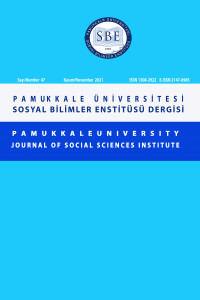Abstract
Günümüzde işletmelerin varlıklarını sürdürmelerini sağlayacak en önemli unsurlardan biri de işletme ya da ürün markasının tüketicilerin gözünde kabulünü sağlamaktır. Markanın tüketici kabulü işletmeler açısından oldukça zor ve yorucu bir süreci içermektedir. Marka kabulünün ilk şartı marka bilinirliğini sağlamaktır. Bu amaçla firmalar bir çok yöntem kullanmaktadırlar. Bu yöntemler içerisinde belki de en vazgeçilmez olanı reklamlardır.
Reklamları etkisinin arttırılması, markanın yada ürünün hatırlanabilirliğinin sağlanması ve nihayetinde marka değerinin oluşturulması işletmeler açısından hayati önem taşımaktadır. Bu amaçla işletmeler marka kimliği oluşturmaya çalışmaktadırlar. Marka kimliği isim, logo ve slogandan oluşmaktadır. Sloganlar doğru ve etkili bir şekilde belirlendiğinde marka kimliğinin vazgeçilmez parçası olmaktadır. Bu çalışmada Türkiye’de faaliyet gösteren firmaların öne çıkan sloganlarının temel özellikleri içerik analizi yöntemiyle incelenmiştir.
References
- Abdi S.; Irandoust A.. "The Importance Of Advertısıng Slogans And Theır Proper Desıgnıng In Brand Equıty". International Journal of Organizational Leadership, 2, 2, 2013, 62-69. doi: 10.33844/ijol.2013.60321
- Boush, D. M. (1993). How advertising slogans can prime evaluations of brand extensions. Psychology & Marketing, 10(1), 67-78.
- Dahlén, M., & Rosengren, S. (2005). Brands affect slogans affect brands? Competitive interference, brand equity and the brand-slogan link. Journal of Brand Management, 12(3), 151-164.
- Ke, Q., & Wang, W. (2013). The Adjective Frequency in Advertising English Slogans. Theory & Practice in Language Studies, 3(2).
- Kohli, C., Leuthesser, L., & Suri, R. (2007). Got slogan? Guidelines for creating effective slogans. Business horizons, 50(5), 415-422.
- Mengü, M. M. (2006). Reklam Sloganları Ve Tüketici Zihni. İstanbul Üniversitesi İletişim Fakültesi Dergisi| Istanbul University Faculty of Communication Journal, (25).
- Petty R.D., Leong S.H.S. & Lwin M.O. (2010) “Slogans, US and EU legal protection for slogans that identify and promote the brand” International Journal of Advertising, 29:3, 473-500, DOI: 10.2501/S0265048710201270
- Pryor, K., & Brodie, R. J. (1998). How advertising slogans can prime evaluations of brand extensions: Further empirical results. Journal of Product & Brand Management.
- Reece B.B. (1984) ,"Children's Ability to Identify Retail Stores From Advertising Slogans", in NA - Advances in Consumer Research Volume 11, eds. Thomas C. Kinnear, Provo, UT : Association for Consumer Research, Pages: 320-323.
- Bonnie B. Reece , Bruce G. Van den Bergh & Hairong Li (1994) What Makes a Slogan Memorable and Who Remembers It, Journal of Current Issues & Research in Advertising, 16:2, 41-57, DOI:10.1080/10641734.1994.10505018
- Stone P J, Dunphy D C, Marshall S S, DM Ogilvie (1966) The General Inquirer: A Computer Approach to Content Analysis, The M.I.T. Press, Massachusetts.
- http://psikolojisozlugu.com/priming-effect-on-hazirlama-etkisi
Abstract
References
- Abdi S.; Irandoust A.. "The Importance Of Advertısıng Slogans And Theır Proper Desıgnıng In Brand Equıty". International Journal of Organizational Leadership, 2, 2, 2013, 62-69. doi: 10.33844/ijol.2013.60321
- Boush, D. M. (1993). How advertising slogans can prime evaluations of brand extensions. Psychology & Marketing, 10(1), 67-78.
- Dahlén, M., & Rosengren, S. (2005). Brands affect slogans affect brands? Competitive interference, brand equity and the brand-slogan link. Journal of Brand Management, 12(3), 151-164.
- Ke, Q., & Wang, W. (2013). The Adjective Frequency in Advertising English Slogans. Theory & Practice in Language Studies, 3(2).
- Kohli, C., Leuthesser, L., & Suri, R. (2007). Got slogan? Guidelines for creating effective slogans. Business horizons, 50(5), 415-422.
- Mengü, M. M. (2006). Reklam Sloganları Ve Tüketici Zihni. İstanbul Üniversitesi İletişim Fakültesi Dergisi| Istanbul University Faculty of Communication Journal, (25).
- Petty R.D., Leong S.H.S. & Lwin M.O. (2010) “Slogans, US and EU legal protection for slogans that identify and promote the brand” International Journal of Advertising, 29:3, 473-500, DOI: 10.2501/S0265048710201270
- Pryor, K., & Brodie, R. J. (1998). How advertising slogans can prime evaluations of brand extensions: Further empirical results. Journal of Product & Brand Management.
- Reece B.B. (1984) ,"Children's Ability to Identify Retail Stores From Advertising Slogans", in NA - Advances in Consumer Research Volume 11, eds. Thomas C. Kinnear, Provo, UT : Association for Consumer Research, Pages: 320-323.
- Bonnie B. Reece , Bruce G. Van den Bergh & Hairong Li (1994) What Makes a Slogan Memorable and Who Remembers It, Journal of Current Issues & Research in Advertising, 16:2, 41-57, DOI:10.1080/10641734.1994.10505018
- Stone P J, Dunphy D C, Marshall S S, DM Ogilvie (1966) The General Inquirer: A Computer Approach to Content Analysis, The M.I.T. Press, Massachusetts.
- http://psikolojisozlugu.com/priming-effect-on-hazirlama-etkisi
Details
| Primary Language | Turkish |
|---|---|
| Subjects | Finance |
| Journal Section | Articles |
| Authors | |
| Publication Date | November 2, 2021 |
| Acceptance Date | May 12, 2021 |
| Published in Issue | Year 2021 Issue: 47 |


